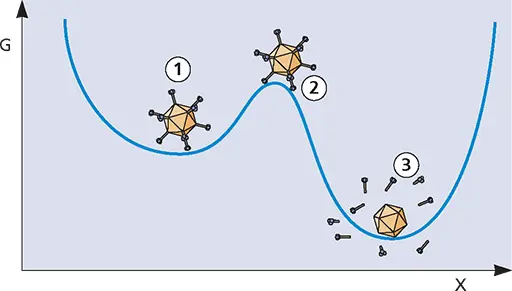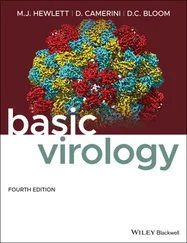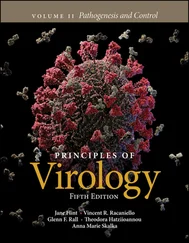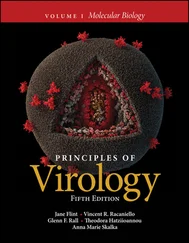Jane Flint - Principles of Virology
Здесь есть возможность читать онлайн «Jane Flint - Principles of Virology» — ознакомительный отрывок электронной книги совершенно бесплатно, а после прочтения отрывка купить полную версию. В некоторых случаях можно слушать аудио, скачать через торрент в формате fb2 и присутствует краткое содержание. Жанр: unrecognised, на английском языке. Описание произведения, (предисловие) а так же отзывы посетителей доступны на портале библиотеки ЛибКат.
- Название:Principles of Virology
- Автор:
- Жанр:
- Год:неизвестен
- ISBN:нет данных
- Рейтинг книги:3 / 5. Голосов: 1
-
Избранное:Добавить в избранное
- Отзывы:
-
Ваша оценка:
- 60
- 1
- 2
- 3
- 4
- 5
Principles of Virology: краткое содержание, описание и аннотация
Предлагаем к чтению аннотацию, описание, краткое содержание или предисловие (зависит от того, что написал сам автор книги «Principles of Virology»). Если вы не нашли необходимую информацию о книге — напишите в комментариях, мы постараемся отыскать её.
Volume I: Molecular Biology
Volume II: Pathogenesis and Control
Principles of Virology, Fifth Edition
Principles of Virology — читать онлайн ознакомительный отрывок
Ниже представлен текст книги, разбитый по страницам. Система сохранения места последней прочитанной страницы, позволяет с удобством читать онлайн бесплатно книгу «Principles of Virology», без необходимости каждый раз заново искать на чём Вы остановились. Поставьте закладку, и сможете в любой момент перейти на страницу, на которой закончили чтение.
Интервал:
Закладка:
In order to create something that functions properly—a container, a chair, a house—its essence has to be explored, for it should serve its purpose to perfection; i.e., it should fulfill its function practically and should be durable, inexpensive and beautiful.
WALTER GROPIUS
Neue Arbeiten der Bauhauswerkstätten, Bauhaus Book no. 7, 1925
Introduction
Virus particles are elegant assemblies of viral, and occasionally cellular, macromolecules. They are marvelous examples of architecture on the molecular scale, with forms perfectly adapted to their functions. Virus particles come in many sizes and shapes ( Fig. 4.1; also see Fig. 1.7) and vary enormously in the number and nature of the molecules from which they are built. Nevertheless, they fulfill common functions and are constructed according to general principles that apply to them all. These properties are described in subsequent sections, which include examples of the architectural detail characteristic of members of different virus families, and nonstructural components of virus particles needed for initiation of infectious cycles.
Functions of the Virion
Virus particles have been selected during evolution for effective transmission of the nucleic acid genome from one host cell to another within a single organism or among host organisms ( Table 4.1). A primary function of an infectious virus particle (called the virion) is protection of the genome, which can be damaged irreversibly by a break in the nucleic acid or by mutation during passage through hostile environments. During its travels, a virus particle may encounter a variety of potentially lethal chemical and physical agents, including proteolytic and nucleolytic enzymes; extremes of pH, humidity, or temperature; and various forms of natural radiation. In all virus particles, the nucleic acid is sequestered within a sturdy barrier formed by extensive interactions among the viral proteins that comprise the protein coat. Such protein-protein interactions can maintain surprisingly stable capsids: many virus particles composed of only protein and nucleic acid survive exposure to large variations in the temperature, pH, or chemical composition of their environment. For example, when dried onto a solid surface, human rotavirus (a major cause of gastroenteritis) loses <20% of its infectivity in 30 days at room temperature, whereas the infectivity of poliovirus (a picornavirus) is reduced by some 5 orders of magnitude within 2 days. This same reduction in infectivity of poliovirus requires >250 days when particles suspended in water are incubated at room temperature at neutral pH. Certain picornaviruses are even resistant to very strong detergents. The highly folded nature of coat proteins and their dense packing to form shells render them largely inaccessible to proteolytic enzymes. Some viruses also possess an envelope, typically derived from cellular membranes, into which viral glycoproteins have been inserted. The envelope adds not only a protective lipid membrane but also an external layer of protein and sugars formed by the glycoproteins. Like the cellular membranes from which they are derived, viral envelopes are impermeable to many molecules and block entry of chemicals or enzymes in aqueous solution.
To protect the nucleic acid genome, virus particles must be stable. However, they must also attach to an appropriate host cell and deliver the genome to the interior of that cell, where the particle is at least partially disassembled. The protective function of virus particles depends on stable intermolecular interactions among their components during assembly, egress from the virus-producing cell, and transmission. On the other hand, these interactions must be reversed readily during entry and uncoating in a new host cell. In only a few cases do we understand the molecular mechanisms by which these apparently paradoxical requirements are met. Nevertheless, it is clear that contact of a virion with the appropriate cell surface receptor or exposure to a specific intracellular environment can trigger substantial conformational changes. Virus particles are therefore metastable assembliesthat have not yet attained the minimum free energy conformation ( Fig. 4.2). The latter state can be attained only once an unfavorable energy barrier has been surmounted, following induction of the irreversible conformational transitions that are associated with attachment and entry. Virions are notsimply inert entities. Rather, they are molecular machines (nanomachines) that play an active role in delivery of the nucleic acid genome to the appropriate host cell and initiation of the reproductive cycle.
PRINCIPLES Structure
Virus particles are constructed to ensure protection and delivery of the genome.
Virus structure can be studied at an atomic level of resolution.
Principles of protein-protein interaction dictate construction of capsids from a small number of subunits.
Rod-like and spherical viruses are built with helical and icosahedral symmetry, respectively.
The primary determinant of capsid size is the number of subunits: the more subunits, the larger the capsid.
There are multiple ways to achieve icosahedral symmetry, even among small viruses.
Large icosahedral capsids contain dedicated stabilizing proteins or multiple protein shells that reinforce one another.
While ordered RNA can be observed, how genomes are condensed and organized within virus particles is largely obscure.
Some large viruses are built with structural elements recognizable from simpler viruses.
Virus particles can contain nonstructural components, including enzymes, small RNAs, and cellular macromolecules.

Figure 4.1 Variation in the size and shape of virus particles. (A)Cryo-electron micrographs of mimivirus and, in the inset (upper left), the parvovirus adeno-associated virus type 4, shown to scale relative to one another to illustrate the ~50-fold range in diameter among viruses that appear roughly spherical. The mimivirus particle (A)is structurally complex: a large number of long, closely packed filaments project from its surface; and one vertex of the capsid carries a unique structure called the stargate, which opens in infected cells to release the viral genome. Rod-shaped viruses also exhibit considerable variation in size, ranging in length from <200 nm to ~2,000 nm. Photos reprinted from Xiao C et al. 2005. J Mol Biol 353:493–496, and Pardon E et al. 2005. J Virol 79:5047–5058, respectively, with permission. Courtesy of Y. Mustafi, National Institutes of Health, and M. Agbandje-McKenna, University of Florida, Gainesville. (B)Nonsymmetric shape of Acidianus bottle-shaped virus isolated from a hot spring in Italy. Adapted from Häring M et al. 2005. J Virol 79:9904–9911, with permission. Courtesy of D. Prangishvili, Institut Pasteur.
Table 4.1 Functions of virion proteins
| Protection of the genome |
| Assembly of a stable protective protein shell |
| Specific recognition and packaging of the nucleic acid genome |
| Interaction with host cell membranes to form the envelope |
| Delivery of the genome |
| Binding to external receptors of the host cell |
| Transmission of signals that induce uncoating of the genome |
| Induction of fusion with host cell membranes |
| Interaction with internal components of the infected cell to direct transport of the genome to the appropriate site |
| Other functions |
| Interactions with cellular components for transport to intracellular sites of assembly |
| Interactions with cellular components to ensure an efficient infectious cycle |

Figure 4.2 Free energy changes in virus particles. Mature virus particles occupy a free energy minimum (1); that is, they are stable, but have not attained the structure with the lowest free energy. Rather, they are primed during assembly and maturation to undergo irreversible conformational transitions (2) that overcome the energy barrier to that lower (more favorable) free energy state (3), and to disassemble at least partially. Such transitions are typically triggered by contact with a host cell receptor or coreceptor or such changes in the environment as a drop in pH. G, free energy; X, reaction coordinate (for example, time after addition of virus particles to susceptible host cells).
Читать дальшеИнтервал:
Закладка:
Похожие книги на «Principles of Virology»
Представляем Вашему вниманию похожие книги на «Principles of Virology» списком для выбора. Мы отобрали схожую по названию и смыслу литературу в надежде предоставить читателям больше вариантов отыскать новые, интересные, ещё непрочитанные произведения.
Обсуждение, отзывы о книге «Principles of Virology» и просто собственные мнения читателей. Оставьте ваши комментарии, напишите, что Вы думаете о произведении, его смысле или главных героях. Укажите что конкретно понравилось, а что нет, и почему Вы так считаете.











